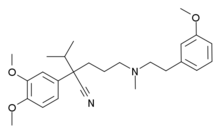Devapamil

| |
| Names | |
|---|---|
| IUPAC name
(RS)-2-(3,4-dimethoxyphenyl)-2-isopropyl-5-[2-(3-methoxyphenyl)ethyl-methylamino]pentanenitrile
| |
| Identifiers | |
3D model (
JSmol ) |
|
| ChEBI | |
| ChEMBL | |
| ChemSpider | |
PubChem CID
|
|
| UNII | |
| |
| |
| Properties | |
| C26H36N2O3 | |
| Molar mass | 424.57564 |
Except where otherwise noted, data are given for materials in their standard state (at 25 °C [77 °F], 100 kPa).
| |
Devapamil is a calcium channel blocker. It is also known as desmethoxyverapamil, which is a phenylalkylamine (PAA) derivative.[1] Devapamil not only inhibits by blocking the calcium gated channels, but also by depolarizing the membrane during the sodium-potassium exchanges.[2]
Structure
Devapamil consists of two aromatic rings with methoxy substituents connected by an alkylamine chain increasing flexibility and overall potency.[3]
Animal studies
Devapamil in rats can be used to decrease glutathione levels and increase oxidation of lipids, which makes it effective in preclusion of ulcers caused by stress.[4][5] The medical characteristics of this drug, and other phenylalkylamines, depends greatly on the state of the calcium channels being targeted which results in a greater affinity and drug efficiency. [6]
